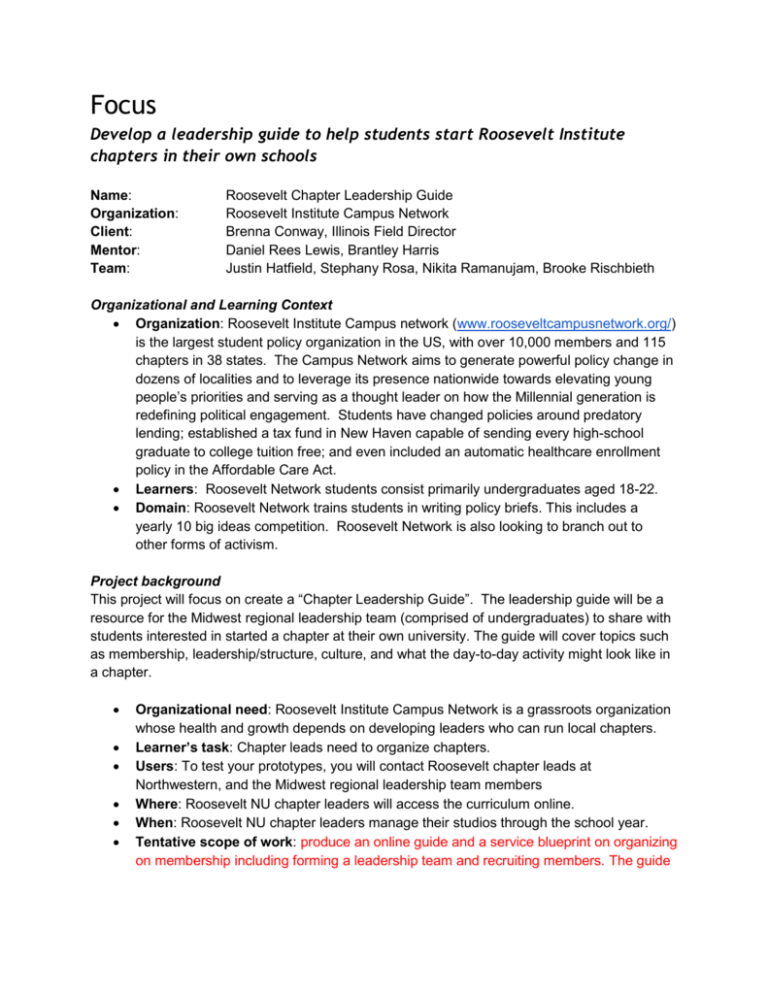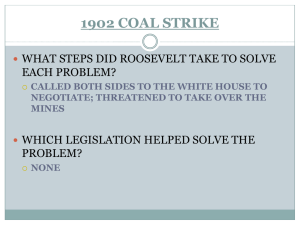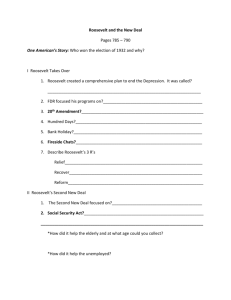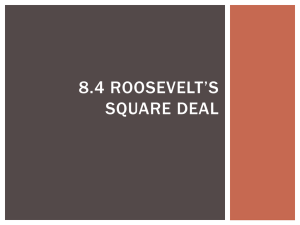Roosevelt Studio Leadership Guide
advertisement

Focus Develop a leadership guide to help students start Roosevelt Institute chapters in their own schools Name: Organization: Client: Mentor: Team: Roosevelt Chapter Leadership Guide Roosevelt Institute Campus Network Brenna Conway, Illinois Field Director Daniel Rees Lewis, Brantley Harris Justin Hatfield, Stephany Rosa, Nikita Ramanujam, Brooke Rischbieth Organizational and Learning Context Organization: Roosevelt Institute Campus network (www.rooseveltcampusnetwork.org/) is the largest student policy organization in the US, with over 10,000 members and 115 chapters in 38 states. The Campus Network aims to generate powerful policy change in dozens of localities and to leverage its presence nationwide towards elevating young people’s priorities and serving as a thought leader on how the Millennial generation is redefining political engagement. Students have changed policies around predatory lending; established a tax fund in New Haven capable of sending every high-school graduate to college tuition free; and even included an automatic healthcare enrollment policy in the Affordable Care Act. Learners: Roosevelt Network students consist primarily undergraduates aged 18-22. Domain: Roosevelt Network trains students in writing policy briefs. This includes a yearly 10 big ideas competition. Roosevelt Network is also looking to branch out to other forms of activism. Project background This project will focus on create a “Chapter Leadership Guide”. The leadership guide will be a resource for the Midwest regional leadership team (comprised of undergraduates) to share with students interested in started a chapter at their own university. The guide will cover topics such as membership, leadership/structure, culture, and what the day-to-day activity might look like in a chapter. Organizational need: Roosevelt Institute Campus Network is a grassroots organization whose health and growth depends on developing leaders who can run local chapters. Learner’s task: Chapter leads need to organize chapters. Users: To test your prototypes, you will contact Roosevelt chapter leads at Northwestern, and the Midwest regional leadership team members Where: Roosevelt NU chapter leaders will access the curriculum online. When: Roosevelt NU chapter leaders manage their studios through the school year. Tentative scope of work: produce an online guide and a service blueprint on organizing on membership including forming a leadership team and recruiting members. The guide should cover what the day-to-day activity might look like in a chapter. The first guide could address recruiting. References Running a chapter-based organization consists of a number of objectives: Leadership -- creating a leadership team and structure for running the studio and member projects Membership -- recruiting members, forming design teams, and managing teams Fundraising -- managing studio finances and raising funds Partners -- Finding and Maintaining Community Partners for project teams. Culture -- Creating a positive social environment, from social activities to swag. Administrative support -- Getting Recognition, Buy-in and Resources from your university campus Training -- Teaching the Policy Analysis process and the hard & soft skills that accompany it. Networking -- Connecting to the larger Roosevelt Network and all the resources in it. Goals Transfer Learners will be able to independently use their learning to … <What kids of long-term independent accomplishments are desired?> T1: Be able to successfully recruit new members to a budding organization T2: Engage members to participate in the core activities of the organization T3: Sustain progress towards organizational goals and objectives Meaning UNDERSTANDINGS Learners will understand that … ESSENTIAL QUESTIONS Learners will keep considering… <What specifically do you want learners to understand? What inferences should they make?> U1: The trends that lead to a successful social media guide and how they can be reapplied/replicated to other social sites U2: The importance of positive social media in the recruiting process U3: The activities that are most effective at engaging members in an organization's’ mission <What thought-provoking questions will foster inquiry, meaning-making and transfer?> Q1: How can I improve my use of social media to attract and engage new chapter members? Q2: How do I ensure members are kept engaged in the organization once they join? Q3: Why should new chapter members be interested/invested in our organization? Q4: How do I ensure my organization sustains progress towards the core mission? Q5: What kinds of everyday activities relate to discovering a strategic mission? Acquisition Students will know… Students will be skilled at… <What facts and basic concepts should students know and be able to recall?> K1: Students will know that effective social media requires personalized engagement and input from various stakeholders <What discrete skills and processes should students be able to use?> S1: Students be skilled event planning detail orientation S2: Students will be skilled at leading teams K2: Students will know that effective social media requires branding and buzz K3: Students will know how to use social media to communicate with both current and potential members K4: Students will know what activities to do, and how to engage, with their new members K5: Students will know that the core mission of Roosevelt Institute is to engage students in politics K6: Students will know that team dynamics at the onset of an establishment are fluid S3: Students will be skilled at navigating ambiguity S4: Students will be skilled at managing multiple projects S5: Students will be skilled at communicating across various levels of a project team S6: Students will be skilled at defining roles S7: Students will be skilled at reflecting on team experiences and correlating said experiences to larger organizational objectives










